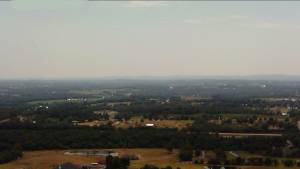The Bandit: Apparently this is NOT the modern Estes "Bandit". (I hate when Estes re-uses model names!!!) This is a beautiful favorite, classic kit from the '70s. This model had built-in ejection gas baffles that require no wadding (in theory). The model also included a reasonably large payload section of 4-1/2 cubic inches. I recently added vent holes for a barometric altimeter. My kit was built with a wire down the main tube to be used as a transmitter antenna (but not used anymore, it was for a high-school science project - won 2nd place!). I used an alternate, longer payload tube and nosecone with features just for the transmitter.
Usually I fly it with a little 'safety' wadding, when I didn't, the 12" chute seriously stuck together but not totally melted, probably because of its age(?). For its weight, it should have a 15-inch parachute anyway. It has been rebuilt with a more reliable nylon parachute. After some motor mount damage on its last flight due to a faulty parachute deployment, this model has been re-built with a better, smaller ejection baffle and a bigger 95mm long motor mount that can handle 24mm wide C, D and E motors, and using an adaptor, the standard 18mm B, C and (composite) D motors. This model of the Bandit I now call the Bantid II.
It now flies very well and quite high with the new motor options! Before it was limited to 400+ feet on a C6 motor; flying higher than the Saturn V Apollo spacecraft, and the Spire of Dublin. With the new mount and a D12 motor, this rocket can fly higher than the Eiffel Tower, the Two Prudential Plaza in Chicago, the Chrysler Building in NY, and the JP Morgan Chase Tower in Houston. If the fins don't shear off, could it even break 2K with a strong E-motor? We'll find out...
---
I have selected this rocket to be the booster for my tiny HD video camera payload. I figure with it's weight, it will only reach about 1/2 its usual altitude: about 500 feet on the D12-5, which should be good enough for aerial photographs. If I need more, I can use the E9. That should certianly lift the 50-gram payload to 1000 feet. I could also try the newer Estes E12! The other modification for the HD camera is that the shock cord is removed, and the rocket will use its own 12" parachute, while the payload section has three 9" parachutes (for redundancy). This way I don't have to worry about the shock-cord snap-back or it separating. I also have a bit of redundancy in the camera's parachutes, if one (or even two) fail to open, hopefully the payload will still fall slow enough to survive.
The seperate parachutes will also allow the camera to fall while still oriented vertical (upside-down), and maybe with less swaying. This version of the Bandit is re-renamed the Bandit HD. The payload bay is now about 7-1/2" long and houses both the Altimeter Two and the camera. A special window was installed in the side of the tube that will screen out UV light to keep the camera sensor working well. It is glass taken from good pair of mirrored sunglasses. My first window attempt used a plastic window, which was the last item to install after all the finishing was done. The night before launch, I glued the window in with CA glue, and it hazed over from the chemicals in the CA, so the flights were scubbed and I cut out the old window and installed the better one. That's why it looks so ugly around the window area (see photo). Next time (I'm making a new booster just for this camera) I'll glue in the non-plastic window then use filler putty to smooth out the edges before painting it. Unlike any other rocket camera project I've ever seen the results of, this camera is oriented horizontal and should take a horizon picture from launch to near apogee. It will NOT look down like all the others. I hope to launch this simultaneously with other rockets to get photos and video of other rockets flying FROM THE AIR! Ideally, I'll get an apogee and 'chute deployment from the air. That would be very different and so cool! So check back!
---
While the Bandit performed well and risked its life a few times in the execution of its photography missions, it has been retired as a camera platform while newer rockets take over the task. The Bandit has been returned to its sport/payload configuration with a 24mm D mount after the E mount was severely damaged. The baffle has been drilled-out and instead a 6x6" Nomex sheet is being used since I have found them to be more reliable. Long live the Bandit!
| Flight Date: | 2012-06-30 |
| Rocket Name: | Bandit |
| Kit Name: | Estes - Bandit {Kit} (1248) [1970-1982] |
| Flyer's Name: | Rich DeAngelis |
| Motors: | D12-5 |
| Expected Altitude: | 660.00 Feet |
| Wind Speed: | 6.00 mph |
| Launch Site: | Fort Indiantown Gap, PA |
| Actual Altitude: | 797.00 Feet |
This was a special flight: the newly re-built Bandit HD was carrying a special payload, a miniature $150 HD video camera as well as a $70 Altimeter 2. The new payload featured three parachutes for redundancy, and no shock cord to snap the rocket back to the payload (the booster had its own parachute). The winds were growing lighter, and with the extra weight on the D12 motor I only expected about half of the typical 1000 foot altitude, so I thought it was safe to fly.
The D12 burned for 1.8 seconds and accelerated the heavy rocket at 11.6 Gs – wow! Average acceleration was 3.6 Gs. It reached a top speed of 142 mph and then coasted for 5.4 seconds. At 787 feet the ejection fired, and 3/10 second later it stopped its upward climb at 797 feet – much higher than expected.
I thought I’d get some nice pictures at that altitude, but worried I’d never get to see them. I lost sight of the rocket, and only after a while spotted the tiny orange parachutes of the payload. I couldn’t see the booster but I wasn’t quite so worried about that.
From 800 feet up (that’s fair – the rocket started 3 feet off the ground you know) the rocket’s payload descended agonizingly slow at only 7 mph with all three ‘chutes fully opened. It seemed to hang in the air forever. It also drifted a good bit and across the road to the next field over 500 feet away. It came very close to landing on the road, and even closer to a tree which I’m sure would snag at least one of its three ‘chutes. Flight time for the payload was 81.4 seconds.
As for the booster, someone from the club said they saw it land “over there”. I went “over there” about 400 feet in the opposite direction (upwind) to find it in the grass without a parachute. Apparently it became stuck in the tube and did not deploy. The already shortened body tube was crushed again, this time a good two inches or so. Also, as happened before, the D12 casing ejected itself instead of ejecting the fourth parachute. Also again, fortunately the D-E engine adaptor was not lost.
As for the pictures, they came out well enough. The boost was rapid and mostly blurry, the audio was great though. During the coast I could hear a distinct, slowing whistle like a bomb dropping. A bit of the parachute was photographed by the side-facing camera, which was designed to then descend upside-down for more horizon pictures. These came out better but the rocking under the three chutes blurred many of them, and there were too many sky pictures for my taste. I learned that my next design will use a much longer tether to the chutes to slow down the rocking motion, and by tethering all three chutes to different points on the bulkhead I believe I can get the rotation to stop. Also, I will not use swivel clips for this attachment. Currently, each of the three ‘chutes has a swivel, and the bulkhead has one too.
Just after deployment, the camera caught three frames of the booster falling in the air, but oddly it appeared white, even though the booster is painted blue and black! Did I instead capture a picture of a UFO? To look at it, you would never identify it as the booster, so by definition it DID capture a UFO up there at 800 feet! (add weird Theremin sounds here.)
I have to dub this flight a success, because its mission was to get aerial photographs and test out this first version of the camera rocket. Too bad the booster was damaged again.
| Stage | Motor(s) |
|---|---|
| 1 | Estes D12-5 |
Sponsored Ads
 |
 |




















